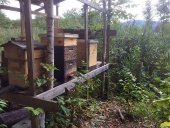Jay Angler wrote:1. time of year
depends on local climate and forage. for me, swarm season is right now.
Jay Angler wrote:2. signs to look for
swarms issuing from a hive are loud. louder than you would think. they're also pretty loud once they've settled someplace. once you hear it, you aren't likely to mistake it for something else. a big cloud of bees is also difficult to misinterpret. if they're obviously coalescing into a clump on some plant or structure, just wait. if they're on the move, they're generally not so fast that you couldn't follow them. rough terrain, fences, rivers,
et cetera might make it rather more difficult.
Jay Angler wrote:3. should the "mini" be near the wild nest, near where the wild bees are feeding etc.
I believe that something like 100 meters from the parent hive was found to be best. search for Seeley's bait hive pdf.
Jay Angler wrote:4. how would one know if he'd captured a wild swarm or a domestic?
it can be difficult to know for certain, but there are some clues. if all the bees have pretty much identical coloration, chances are that they're all the daughters of an artificially bred queen. if they've got a variety of coloration, though, their mom was almost certainly wild-mated. spotting the queen with a dab of paint on her back is a sure sign of a purchased queen. there are getting to be more and more "domestic" bees that are wild-mated, though, and if you end up with a swarm from such a colony, you'll still be in pretty good shape. and I don't turn away swarms from artificially bred queens. they're likely to supersede her in relatively short order, anyhow, at which point they'll have a wild-mated queen making babies from there forward.
Jay Angler wrote:5. How high off the ground should the 'mini' be placed or does it matter?
in practice, as high as is convenient for you. five meters high is probably better than two meters, but do you want to be carrying a heavy box full of bees five meters up a ladder?
Jay Angler wrote:6. is there a size for the 'mini' you'd recommend? I was thinking two feet long with matching top bars, but thinner wood than the large one I'm planning, because I'm small and need things to not be too heavy to manage.
40 liters is the size Seeley found to be best. he didn't parse it very fine if I remember, though, only giving swarms the choice of 10 liters, 40 liters, and 100 liters. 40 liters is a fairly convenient size, though. using thinner wood for the body of the bait hive is fine, but I would recommend using the same top bars you'll use in your permanent hive. that way you can just transfer the bars directly from the bait hive into the permanent hive. this will make things much easier if you don't notice for a few days that a swarm has moved in and they've had a chance to build a fair amount of comb.
Jay Angler wrote:And most important, once you've got a wild swarm in your mini:
1. how do you get it moved to your full sized top-bar hive
I would suggest fixing all the top bars in your bait hive together. that way, you can lift them out as a unit and transfer them to the permanent hive. use screws to fix them together so you can more easily return them to individual use once you've made the transfer. a good portion of the bees will be occupying/working on/building/hanging from the combs that they are already building on the top bars. the rest will follow if you leave the bait hive open near the permanent hive. you'll notice bees fanning at the entrance, which is meant to spread Nasanov scent that returning bees will follow to the new hive.
Jay Angler wrote:2. is there a best time to do the move
yeah. towards dusk. if you wait until everybody's back to the bait hive for the day, you won't leave any behind at the bait site. they'll also be less likely to abscond in the evening, and they'll be settled into their new digs by the time is warm
enough to fly the next morning. probably.
Jay Angler wrote:These may seem like goofy questions, but I've never done any of this before. I've got wood marked for my first top-bar hive, but haven't managed to get to the next step due to other priorities. I think that part of my hesitation to build is uncertainty about managing the next steps. Bees are under such pressure, I want to be successful and not put bees at more risk.
Thanks
not at all. all of this can be intimidating. but you're starting the right way. this will positively color your relationship with bees for the rest of your life.
remember, though, that nothing is ever certain with bees. there is no guarantee they'll choose your bait hive, even if you do everything right. the more bait hives you put out, the better your odds are, but you'll never get close to 100%. for that reason, I recommend also putting the word out that you're looking for swarms. collecting a swarm is marginally more work than transferring from a bait hive, but it's rather enjoyable work.





 1
1




 1
1

































